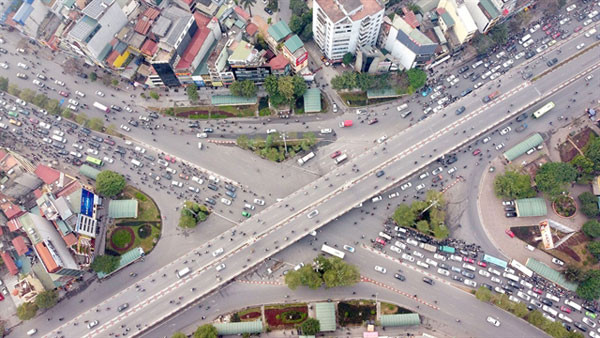
Authorities added that the programme would continue being adjusted if the current strategy did not work.
During this programme, vehicles on Lang Street will not be allowed to turn left to Tay Son Street but must go past the intersection 760 metres and turn around at the designated spot on Truong Chinh Street.
From this point, motorists can go straight ahead for Lang Street or turn right for Tay Son Street.
Vehicles going from Nguyen Trai Street towards the intersection are also banned from going straight to Tay Son Street or turning left to Lang Street. Instead, they must go to the designated turning point on Truong Chinh Street on their right.
A turning spot under the overpass bridge on Tay Son Street is also open.
Prior to Nga Tu So, several other traffic congestion hotspots, such as To Huu - Vu Trong Khanh - Hoang Minh Giam - Nguyen Chanh - Tran Duy Hung and Hoang Minh Giam - Hoang Ngan - Nguyen Thi Thap, also underwent traffic flow rearrangement programmes.
Reporting from the To Huu - Vu Trong Khanh intersection, Giao Thông (Transport) newspaper said that traffic congestion is being alleviated when the heavy flow of vehicles from To Huu Street must go straight ahead instead of turning left like in the past.
The situation at Tran Duy Hung Road and the Hoang Minh Giam - Hoang Ngan route during rush hours and weekends has also improved.
A representative from the city’s Traffic Police Team No 7 said that motorists who don’t comply with the regulations are all recorded and dealt with.
Tran Huu Bao, deputy director of the Hanoi transport department, said: “On days leading to Tet (Lunar New Year), traffic flows increase and exceed the capacity of several intersections. While there is congestion, there are no longer prolonged traffic jams.”
He added that the department was proposing the city’s People’s Committee officially implement the new flow directions following these pilot programmes while also reviewing all city routes for better traffic arrangement.
To optimise the organisation of traffic infrastructure, Hanoi transport department also suggested the People’s Committee acquire software for traffic simulation and measurement, which would serve as a visual analysis tool for better management.
These tools, along with the accompanying equipment such as fly cams, are expected to cost over VND1 billion (US$42,600).
Nguyen Phi Thuong, director of the capital city’s transport department, said that the application of traffic simulation software would visually illustrate the current state of traffic flows and the planned arrangement and contribute to the optimal conditions for traffic planning.
On Hanoi’s efforts in rearranging the traffic, Do Cao Phan, a lecturer at the Industrial University of HCM City, said that while the capital’s infrastructure cannot yet respond to the rise in the number of vehicles, traffic rearrangement is an immediate solution that could bring about fast results while is also cost-effective.
He said: “The people’s awareness plays a significant part in determining whether a traffic re-organising plan is successful.
“It is necessary to raise this awareness and active communication, alongside warnings and fines for violations.”
Phan also added that authorities need to monitor and adjust the plans according to the transport needs of the people, such as changing the distance to several turning points near the piloted intersections, lengthening traffic barriers on Nguyen Trai Street, and installing large, easy-to-read signs for motorists.
Hanoi currently has 7.7 million vehicles, of which there are more than one million cars, 6.5 million motorbikes and 180,000 electric motorbikes, alongside approximately 1.2 million vehicles coming from other cities and provinces. The total figure increased by 4 to 5 per cent in recent years annually.
Meanwhile, the ratio of land for traffic to new urban areas is around 10.07 per cent, the land for static travel occupies less than one per cent and public transportation 17.8 per cent.
Source: Vietnam News